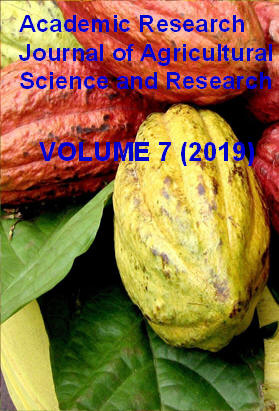|
Vol. 7(1), pp. 21-30, January 2019
DOI: 10.14662/ARJASR2018.102
Copy©right 2019
Author(s) retain the copyright of this article
ISSN: 2360-7874
http://www.academicresearchjournals.org/ARJASR/Index.htm
Full
Length Research
Genetic Divergence Analysis of Ethiopian White Lupine (Lupinus albus L.)
Accessions in Bale Zone, South East, Ethiopia
Tadesse Adere 1 and Temesgen Bedassa Gudeta2
1Department
of Biology,Gasera Preparatory School, P.O. Box 37, Robe, Ethiopia.
2Department
of Biology, Madda Walabu University, P.O. Box 247, Robe, Ethiopia.
*Corresponding Author: E-mail:tasgabifenet@gmail.com alternative E-mail:singitentem@gmail.com
Tele: +251911785364
Accepted 13 January 2019
White lupin (Lupinu albus L.) is a promising leguminous crop for human
consumption, green manure, forage and has been traditionally cultivated
for several years in Mediterranean region along the Nile valley where it
iswas originated. In Ethiopia, it has been exclusively produced
by smallholder farmers; mainly for its food grain and maintenance of
soil fertility. The objectives of the study were to cluster the
genotypes into genetically different groups and to quantify the genetic
distance among the clusters. Field experiments were conducted on 36
Ethiopian white lupin accessions at two locations namely Madda Walabu
University Research Site and Gasera farmers’ farm land during the main
cropping season of the year 2017. Randomized Complete Block Design with
three replications was used and eighteen morphological quantitative
traits were studied at both locations. The collected data were adjusted
to mean values and the mean values were standardized to mean of zero and
unity variance in order to minimize biases due to differences in scales
of measurement and then subjected to analysis of variance using
appropriate SAS computer software. The combined analysis of variance
showed very highly significant (p<0.0001) and highly significant
(p<0.01) differences among the studied genotypes for all
characters, except for the traits number of primary branches and pod
thickness.
Although
all
the tested 36 white lupin landraces were originally collected from
diverse agro-ecologies of Ethiopia, in this study they were grouped in
to only five clusters based on the studied genetic traits.
The
maximum inter-cluster distance
(D2=641.87) was observed between cluster three and five; the
lowest value (D2=28.70) was observed between cluster two and
four. Maximum intra-cluster value (D2= 3.07) was exhibited by
cluster four followed by cluster one and cluster two. Cluster three and
five each held solitary accession, hence, their intra-cluster, D2,
value was zero. Therefore, crossing of accessions from cluster three and
five will give rise to maximum genetic segregation. The selection of
parents on the basis of divergence analysis would be more promising for
breeding program.
Key
Words:
Bale Zone,Cluster analysis, Gasera, Genetic divergence, Madda Walabu,
White lupin.
How to
cite this article (APA Style):
Tadesse, A., Temesgen, B.G (2019). Genetic Divergence Analysis of
Ethiopian White Lupine (Lupinus albus L.) Accessions in Bale Zone, South
East, Ethiopia. Acad. Res. J. Agri. Sci. Res. 7(1): 21-30 |
